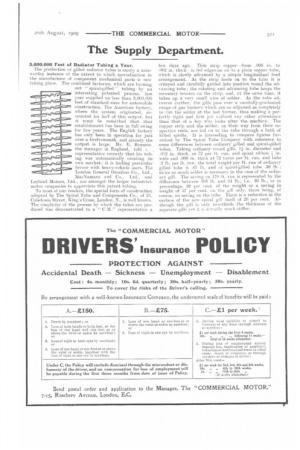The Supply Department.
Page 21

If you've noticed an error in this article please click here to report it so we can fix it.
3,000,000 Feet of Radiator Tubing a Year.
The production of gilled radiator tubes is surely a noteworthy instance of the extent to which specialization in the manufacture of component mechanical parts is now taking place. The combined factories, which are turning
out " " tubing by an interesting patented process, last year supplied no less than 3,000,000 feet of standard sizes for automobile construction. The American factory, where the system originated, accounted for half of this output, but it must be remarked that that establishment has been in full swing for five years. The English factory has only been in operation for just over a twelvemonth, and already the output is large. Mr. E. Bennett.. the manager in England, told (, representative recently that his tubing was automatically creating its own market ; it is finding particular favour with heavy-vehicle users. The London General Omnibus Co., Ltd., MacNamara and Co., -Ltd., and Leyland Motors, Ltd., are amongst the larger industrialmotor companies to appreciate this patent tubing.
To most of our readers, the special form of construction adopted by The Spiral Tube and Components Co., of 2.1, Caledonia Street, King's Cross, London, N., is well known. The simplicity of the process by which the tubes are produced was demonstrated to a " CM." representative a few days ago. Thin strip copper—from .008 in. to .002 in. thickis fed edgewise on to a plain copper tube, which is slowly advanced by a simple longitudinal feed arrangement. As the strip feeds on to the tube it is crimped and carefully guided into position round the advancing tube; the rotating and advancing tube keeps the necessary tension on the strip, and, at the same time, it takes up a very small wire of solder. As the tube advances further, the gills pass over a carefully-graduated range of gas burners which are so adjusted as completely to run the solder at the last, burner, thus making a perfectly tight and firm job s‘ ithont any other attendance than that of a boy who looks after the machine. The copper strip and the solder, on their way from their respective reels, are fed on to the tube through a bath of killed spirits. It is interesling to compare figures furnished by The Spiral Tulle Company with reference to seine differences between ordinary gilled and spiral-gilled tubes. Taking ordinary round gills, 1,1 in. diameter and
.012 in. thick, at 72 per ft. run, and spiral ribbon in. wide and .008 in. thick at 72 turns per ft. run, and tube .2 lb. per ft. run. the total weight per ft. run of ordinary gilled tube is .61 lb. and of spiral-gilled tube .38 lb. ; twice as much solder is necessary in the case of the ordinary gill. The saving on 170 ft. run is represented by the difference between 103 lb. and 64 lb., i.e.. 39 lb., or in percentage, 38 per cent, of the weight or a saving in weight of 57 per cent. On the gill (ally, there being, of course, no saving on the tube. There is a reduction in the surface of the new spiral gill itself of 26 per cent. Although the gill is only two-thirds the thickness of the separate gills yet it is aetttally much stiffer.






















